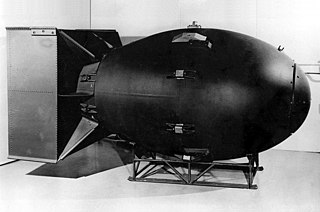
A warhead is the explosive or toxic material that is delivered by a missile, rocket, or torpedo. It is a type of bomb.

The McDonnell F-101 Voodoo was a supersonic jet fighter which served the United States Air Force (USAF) and the Royal Canadian Air Force (RCAF).

Yellow Sun was the first British operational high-yield strategic nuclear weapon. The name actually refers only to the outer casing; the warhead was known as "Green Grass" and "Red Snow". The ENI or electronic neutron initiator (generator) was Blue Stone.

The B61 nuclear bomb is the primary thermonuclear gravity bomb in the United States Enduring Stockpile following the end of the Cold War. It is a low to intermediate-yield strategic and tactical nuclear weapon featuring a two-stage radiation implosion design.
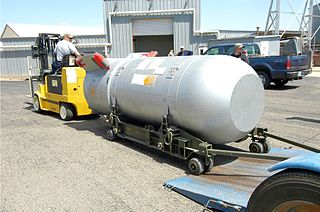
The Mk/B53 was a high-yield bunker buster thermonuclear weapon developed by the United States during the Cold War. Deployed on Strategic Air Command bombers, the B53, with a yield of 9 megatons, was the most powerful weapon in the U.S. nuclear arsenal after the last B41 nuclear bombs were retired in 1976.
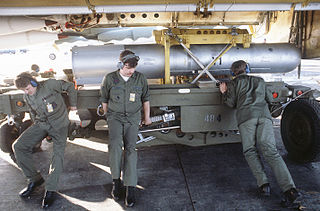
The B28, originally Mark 28, was a thermonuclear bomb carried by U.S. tactical fighter bombers, attack aircraft and bomber aircraft. From 1962 to 1972 under the NATO nuclear weapons sharing program, American B28s also equipped six Europe-based Canadian CF-104 squadrons known as the RCAF Nuclear Strike Force. It was also supplied for delivery by UK-based Royal Air Force Valiant and Canberra aircraft assigned to NATO under the command of SACEUR. In addition, certain U.S. Navy carrier based attack aircraft such as the A3D Skywarrior, A4D Skyhawk, and A3J Vigilante were equipped to carry the MK 28.
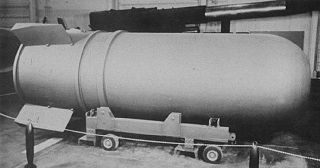
The B-41 was a thermonuclear weapon deployed by the United States Strategic Air Command in the early 1960s. It was the most powerful nuclear bomb ever developed by the United States, with a maximum yield of 25 megatons. The B-41 was the only three-stage thermonuclear weapon fielded by the U.S.

The W80 is a low to intermediate yield two-stage thermonuclear warhead deployed by the U.S. enduring stockpile with a variable yield ("dial-a-yield") of 5–150 kt of TNT.

A thermonuclear weapon, or fusion weapon, is a second-generation nuclear weapon design which affords vastly greater destructive power than first-generation atomic bombs. Modern fusion weapons consist essentially of two main components: a nuclear fission primary stage and a separate nuclear fusion secondary stage containing thermonuclear fuel: the heavy hydrogen isotopes deuterium and tritium, or in modern weapons lithium deuteride. For this reason, thermonuclear weapons are often colloquially called hydrogen bombs or H-bombs.

Mark 7 "Thor" was the first tactical fission bomb adopted by US armed forces. It was also the first weapon to be delivered using the toss method with the help of the low-altitude bombing system (LABS). The weapon was tested in Operation Buster-Jangle. To facilitate external carry by fighter-bomber aircraft, Mark 7 was fitted with retractable stabilizer fins. The Mark 7 warhead (W7) also formed the basis of the 30.5 inches (775 mm) BOAR rocket, the Mark 90 Betty nuclear depth charge, MGR-1 Honest John rocket, and MGM-5 Corporal ballistic missile. It was also supplied for delivery by Royal Air Force Canberra aircraft assigned to NATO in Germany under the command of SACEUR. This was done under the auspices of Project E, an agreement between the United States and the UK on the RAF carriage of US nuclear weapons. In UK use it was designated 1,650 lb. H.E. M.C. The Mark 7 was in service from 1952 to 1967(8) with 1700–1800 having been built.
The W49 was an American thermonuclear warhead, used on the Thor, Atlas, Jupiter, and Titan I ballistic missile systems. W49 warheads were manufactured starting in 1958 and were in service until 1963, with a few warheads being retained until 1975.
The B46 nuclear bomb was an American high-yield thermonuclear bomb which was designed and tested in the late 1950s. It was never deployed. Though originally intended to be a production design, the B46 ended up being only an intermediate prototype which was test fired several times. These prototypes were known as TX-46 units (Test/Experimental).
The W56 was an American thermonuclear warhead produced starting in 1963 which saw service until 1993, on the Minuteman I and II ICBMs.
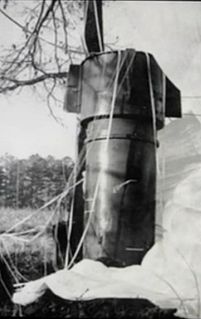
The Mark 39 nuclear bomb and W39 nuclear warhead were versions of an American thermonuclear weapon, which were in service from 1957 to 1966.
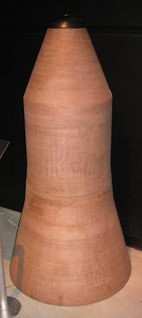
The W59 was an American thermonuclear warhead used on some Minuteman I ICBM missiles from 1962-1969, and planned to be used on the cancelled GAM-87 Skybolt air-launched ballistic missile.
The W38 was an American thermonuclear warhead used in the early to mid-1960s as a warhead for Atlas E and F, and LGM-25 Titan I ICBMs. It was first built in 1961 and was in service from 1961 to 1965. 70 were deployed on Titan I missiles and 110 on Atlas missiles. It used the Avco Mark 4 reentry vehicle.

The Mark 101 Lulu was an airdropped nuclear depth charge developed by the U. S. Navy and the Atomic Energy Commission during the 1950s. It carried a W34 nuclear warhead, with an explosive yield of about 11 kilotons. It was deployed by the U.S. Navy for the purposes of antisubmarine warfare, in at least five different models, from 1958 through 1971. These nuclear weapons were also stockpiled overseas at the bases of NATO allies, under American military guard and control, for the potential use by maritime patrol planes of NATO. Thus was most notable at the air base of RAF St. Mawgan in Cornwall, for potential use by British Avro Shackleton patrol planes and the Royal Dutch Navy's P-2 Neptune and P-3 Orion patrol planes. Neither the Lulu nor any other kind of nuclear antisubmarine or antiship weapon was ever used in combat by any country.

The Mark 15 nuclear bomb, or Mk-15, was a 1950s American thermonuclear bomb, the first relatively lightweight thermonuclear bomb created by the United States.
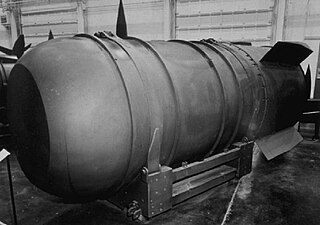
The Mark 36 was a heavy high-yield United States nuclear bomb designed in the 1950s. It was a thermonuclear bomb, using a multi-stage fusion secondary system to generate yields up to about 10 megatons.


